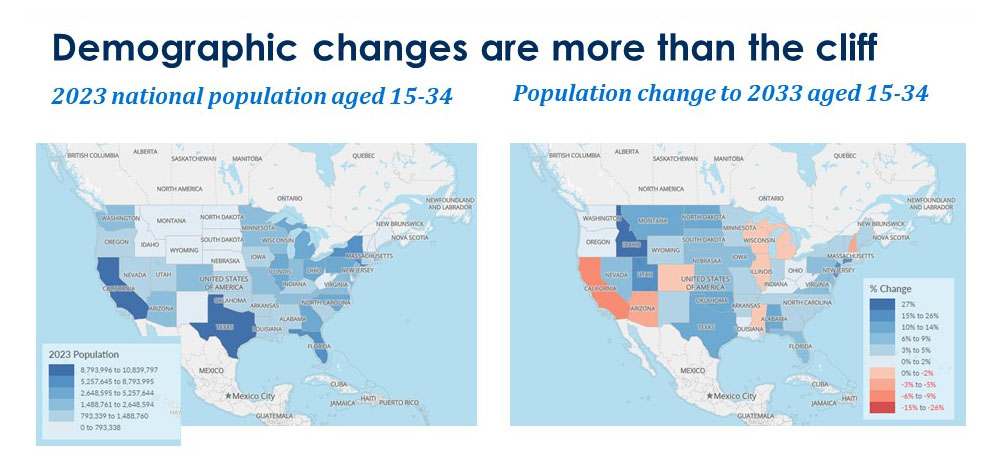enrollment
Demographic Changes Are More Than the Cliff: 5 Crucial Questions to Ask About Your Markets
Co-authored by Dr. Ken Newbold, Associate Vice President for Market and Research Services, RNL
Did you make any New Year’s resolutions for 2024? Professionally, you may have set a goal to better understand the markets (students) your college or university serves, how those markets are changing, and what new markets that may be available to you. While we know that higher education has been focused on the impact of the demographic cliff for years, opportunities exist for colleges and universities that understand changing demography and can apply that understand to support data-informed planning processes and seek innovative approaches to serving new markets.
It is crucial to understand that demographic change varies at the national, regional, state, and local levels. While understanding macro-demographic trends is beneficial, it is essential to understand how macro and local trends impact your specific college or university.
For example: Some markets are contracting for those aged 15-34 years old while others will see growth. Where does your market stand?

5 Crucial Questions to Ask
1. Where do our students come from and does that vary by student type?
Many colleges and universities have a general or anecdotal sense of geographic regions where their students come from. Consider reviewing admissions funnel data to understand the regions, states, and localities that your new students come from. Look for shifting trends in geographic regions in the funnel data to identify emerging or declining markets. Be aware that your main or emerging markets may vary based on student population. Seek out trends specific to undergraduate, adult, graduate, and online students.
2. Are the demographics changing in our core markets?
Once you’ve identified your core existing recruitment markets, utilize external demographic data to understand if and how they are changing. Is your core market forecast to experience an increase, stability, or decline? Ask critical questions of the data and explore whether those patterns vary by market, student population, or student type. For example, is your core market aging leading to fewer high school seniors who may enter your institution as traditional undergraduates but potential more nontraditional undergraduates or graduate students. Is your core market(s) experiencing shift if population composition by race/ethnicity?
3. Are the demographics changing in adjacent markets?
Understanding your secondary and adjacent markets is as critical as understanding your core recruitment markets. If markets near you are contracting, other institutions that traditionally have recruited in those markets will likely be seeking to expand into other more stable or growing markets. If your market is stable or growing, how do you anticipate where increased competition may arise due to changes in adjacent markets?
4. What do we do if our core markets are declining?
If your core markets are declining, there are various strategies to sustain or grow enrollment. Are there markets that are stable or growing that you could expand into? This could be either geographically or by student type. Additionally, consider ways to increase your share in existing markets. Growing your share in existing markets requires both an understanding of the demography of the market, but also a deep understanding of the competition for students in that market.
5. Can we build strategies to support our enrollment goals using this market intel?
Absolutely! The goal of understanding your markets is to allow you to develop a robust knowledge of those markets in order to build strategy to support your enrollment goals. These strategies could include identifying new geographic markets to recruit from, intentional strategies to recruit and serve specific student population such as undergraduate adult learners or Hispanic first-time freshmen, or the identification of strategic initiatives to increase market share in core markets.
Explore more in our webinar or reach out to discuss what you would like to learn about your markets
A comprehensive and nuanced understanding of the demographic trends impacting your college or university will allow you to communicate clearly with your constituents, develop relevant programs to serve your student population, and create strategies that will position you for success into the future.
You can learn more about this by watching our webinar How to Harness External Influences to Enhance Your Strategic Advantage, where we share additional insights into trends and how you can use research to guide your planning.
Or reach out to our experts and find out how you further explore your markets to gain a strategic advantage. We work with institutions of all sizes, types, and missions, and we can help you better understand your students, competition, market conditions, and other factors. Contact us today for a complimentary consultation.

